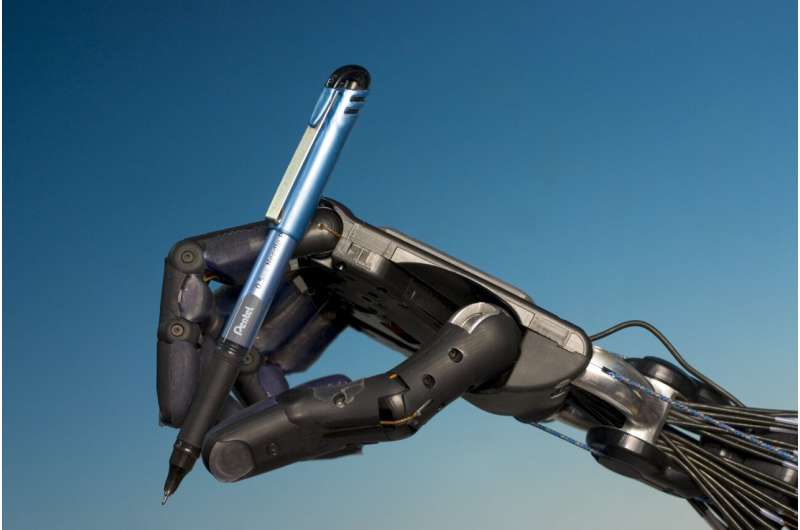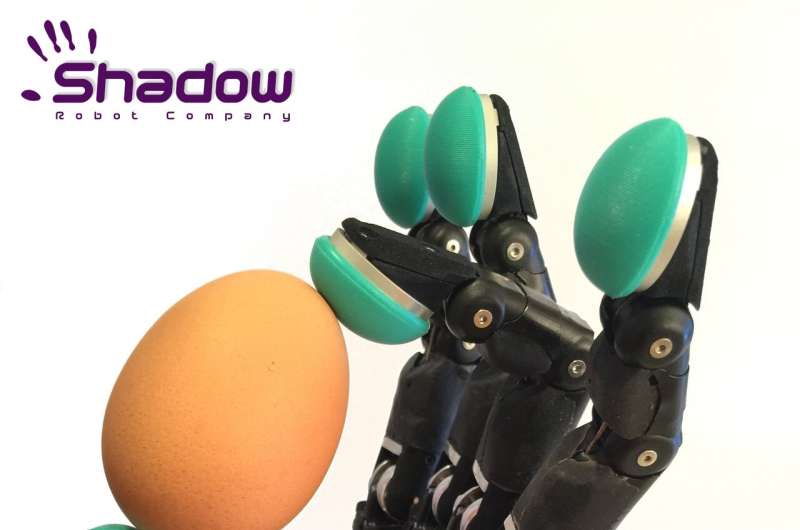Robot hands one step closer to human thanks to AI algorithms

The Shadow Robot Dexterous Hand is a robot hand, with size, shape and movement capabilities similar to those of a human hand. To give the robotic hand the ability to learn how to manipulate objects researchers from WMG, University of Warwick, have developed new AI algorithms.
Robot hands can be used in many applications, such as manufacturing, surgery and dangerous activities like nuclear decommissioning. For instance, robotic hands can be very useful in computer assembly where assembling microchips requires a level of precision that only human hands can currently achieve. Thanks to the utilization of robot hands in assembly lines, higher productivity may be achieved whilst securing reduced exposure from work risk situations to human workers.
In the paper, "Solving Challenging Dexterous Manipulation Tasks With Trajectory Optimisation and Reinforcement Learning," researchers Professor Giovanni Montana and Dr. Henry Charlesworth from WMG, University of Warwick have developed new AI algorithms—or the "brain"—required to learn how to coordinate the fingers' movements and enable manipulation.
Using physically realistic simulations of Shadow's robotic hand, the researchers have been able to make two hands pass and throw objects to each other, as well as spin a pen between its fingers. The algorithms however are not limited to these tasks but can learn any task as long as it can be simulated. The 3-D simulations were developed using MuJoCo (Multi-Joint Dynamics withContact), a physics engine from the University of Washington.

The researchers' approach uses two algorithms. Initially, a planning algorithm produces a few approximate examples of how the hand should be performing a particular task. These examples are then used by a reinforcement learning algorithm that masters the manipulation skills on its own. By taking this approach, the researchers have been able to produce significantly better performance compared to existing methodologies. The simulation environments have been made publicly available for any researcher to use.
Now that the algorithms have been successful in the simulations, Professor Montana's team will continue to work closely with Shadow Robot and test the AI methodology on real robotic hardware, which could see the hand advance one step closer to use in the real day to day life.
In a second paper, "PlanGAN: Model-based Planning With Sparse Rewards and Multiple Goals," to be presented at the 2021 NeurIPS conference, the WMG researchers have also developed a novel and general AI approach that enables robots to learn tasks such as reaching and moving objects, which will further improve hand manipulation applications.
Professor Giovanni Montana, from WMG, University of Warwick comments, "The future of digitalisation relies on AI algorithms that can learn autonomously, and to be able to develop algorithms that give Shadow Robot's hand the ability to operate like a real one is without any human input is an exciting step forward. These autonomous hands could be used in the future to deliver robotic surgeons, to increase the productivity of assembly lines and to replace humans in dangerous jobs such as bomb disposal."
"In future work we will let the robots perceive the environment as accurately as humans do, not only through computer vision algorithms that can see the world, but through sensors that detect temperature, force and vibrations so the robot can learn what to do when it feels those sensations."
Rich Walker, managing director of the Shadow Robot Company, in London, comments: "When we started building dexterous hands, it was because there was no way to get hold of one without building it! 20 years later, we are now seeing researchers like Giovanni deliver the promise of the hardware by creating algorithms clever enough to control the robot hand—soon perhaps we will see super-human performance?"
More information: Henry Charlesworth, Giovanni Montana. Solving Challenging Dexterous Manipulation Tasks With Trajectory Optimisation and Reinforcement Learning. arXiv:2009.05104 [cs.RO]. arxiv.org/abs/2009.05104


















